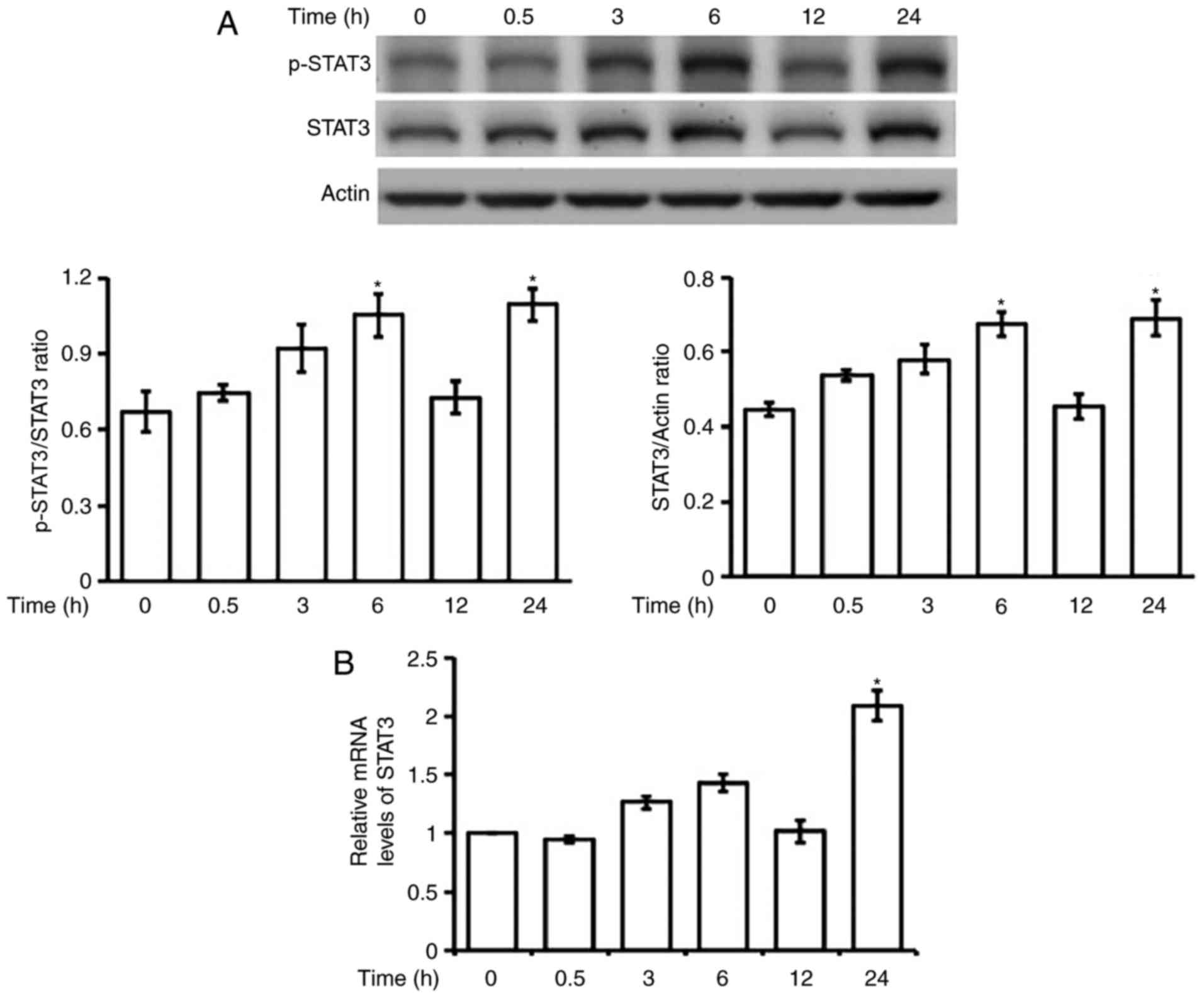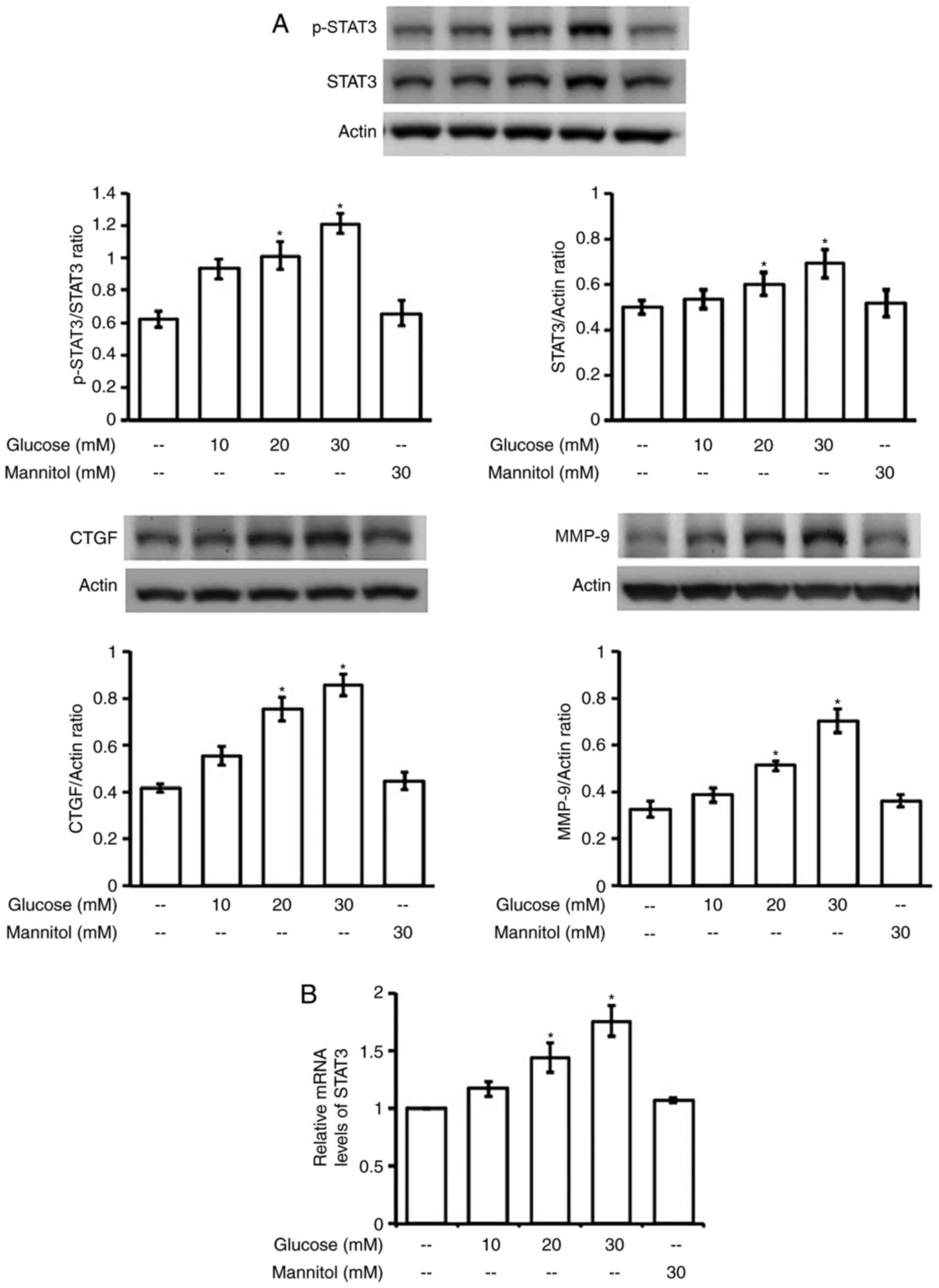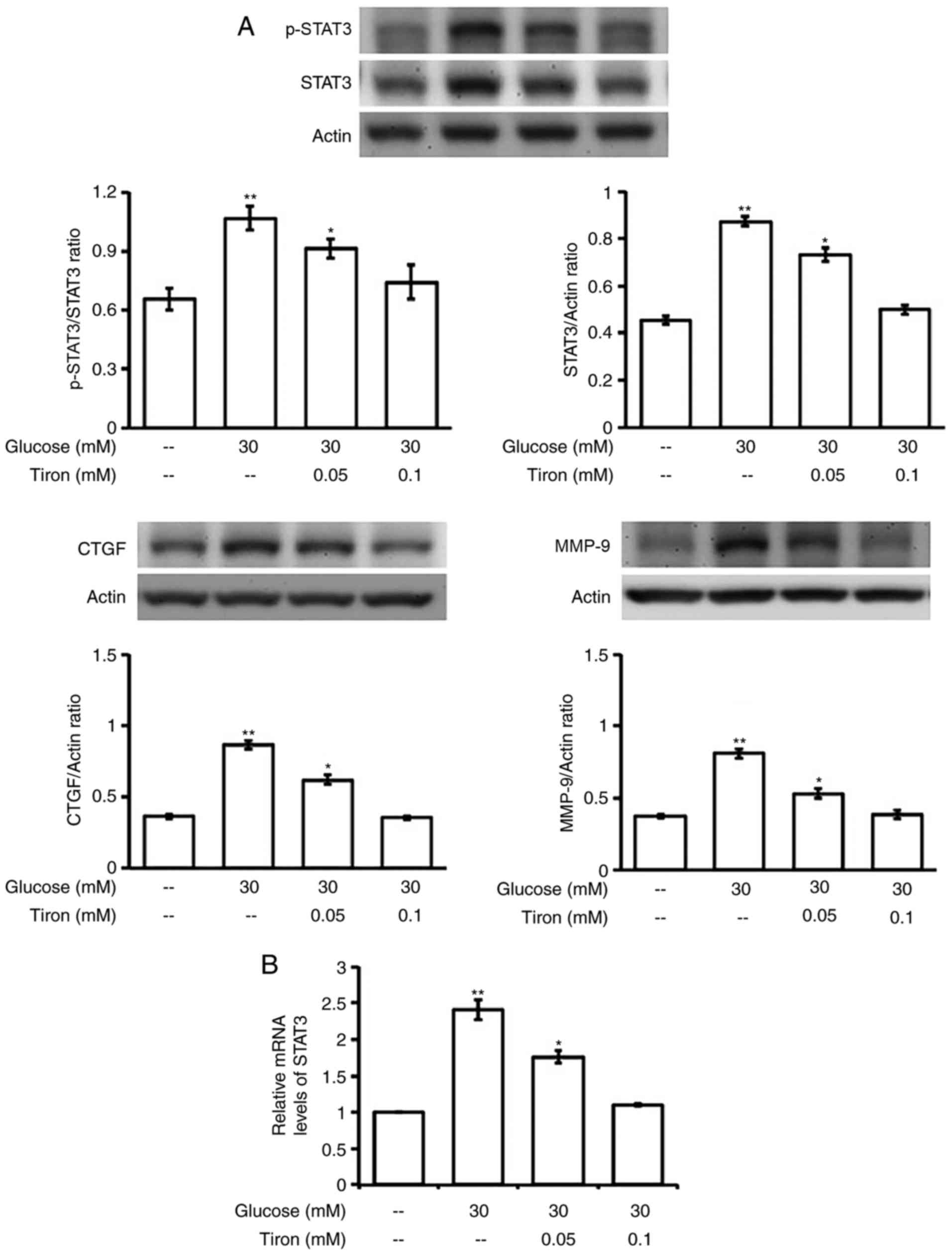|
1
|
Haghikia A, Ricke-Hoch M, Stapel B, Gorst
I and Hilfiker-Kleiner D: STAT3, a key regulator of cell-to-cell
communication in the heart. Cardiovasc Res. 102:281–289. 2014.
View Article : Google Scholar : PubMed/NCBI
|
|
2
|
Boengler K, Hilfiker-Kleiner D, Heusch G
and Schulz R: Inhibition of permeability transition pore opening by
mitochondrial STAT3 and its role in myocardial
ischemia/reperfusion. Basic Res Cardiol. 105:771–785. 2010.
View Article : Google Scholar : PubMed/NCBI
|
|
3
|
Elschami M, Scherr M, Philippens B and
Gerardy-Schahn R: Reduction of STAT3 expression induces
mitochondrial dysfunction and autophagy in cardiac HL-1 cells. Eur
J Cell Biol. 92:21–29. 2013. View Article : Google Scholar : PubMed/NCBI
|
|
4
|
Heusch G, Musiolik J, Gedik N and
Skyschally A: Mitochondrial STAT3 activation and cardioprotection
by ischemic postconditioning in pigs with regional myocardial
ischemia/reperfusion. Circ Res. 109:1302–1308. 2011. View Article : Google Scholar : PubMed/NCBI
|
|
5
|
Wegrzyn J, Potla R, Chwae YJ, Sepuri NB,
Zhang Q, Koeck T, Derecka M, Szczepanek K, Szelag M, Gornicka A, et
al: Function of mitochondrial Stat3 in cellular respiration.
Science. 323:793–797. 2009. View Article : Google Scholar : PubMed/NCBI
|
|
6
|
Haghikia A, Stapel B, Hoch M and
Hilfiker-Kleiner D: STAT3 and cardiac remodeling. Heart Fail Rev.
16:35–47. 2011. View Article : Google Scholar : PubMed/NCBI
|
|
7
|
Hilfiker-Kleiner D, Hilfiker A, Fuchs M,
Kaminski K, Schaefer A, Schieffer B, Hillmer A, Schmiedl A, Ding Z,
Podewski E, et al: Signal transducer and activator of transcription
3 is required for myocardial capillary growth, control of
interstitial matrix deposition and heart protection from ischemic
injury. Circ Res. 95:187–195. 2004. View Article : Google Scholar : PubMed/NCBI
|
|
8
|
Zouein FA, Kurdi M and Booz GW: Dancing
rhinos in stilettos: The amazing saga of the genomic and nongenomic
actions of STAT3 in the heart. JAKSTAT. 2:e243522013.PubMed/NCBI
|
|
9
|
Wang S, Li B, Li C, Cui W and Miao L:
Potential renoprotective agents through inhibiting CTGF/CCN2 in
diabetic nephropathy. J Diabetes Res. 2015:9623832015. View Article : Google Scholar : PubMed/NCBI
|
|
10
|
Miller AM, Wang H, Bertola A, Park O,
Horiguchi N, Ki SH, Yin S, Lafdil F and Gao B:
Inflammation-associated interleukin-6/signal transducer and
activator of transcription 3 activation ameliorates alcoholic and
nonalcoholic fatty liver diseases in interleukin-10-deficient mice.
Hepatology. 54:846–856. 2011. View Article : Google Scholar : PubMed/NCBI
|
|
11
|
Jung JE, Lee HG, Cho IH, Chung DH, Yoon
SH, Yang YM, Lee JW, Choi S, Park JW, Ye SK and Chung MH: STAT3 is
a potential modulator of HIF-1-mediated VEGF expression in human
renal carcinoma cells. FASEB J. 19:1296–1298. 2005.PubMed/NCBI
|
|
12
|
Chen Y, Wang JJ, Li J, Hosoya KI, Ratan R,
Townes T and Zhang SX: Activating transcription factor 4 mediates
hyperglycaemia-induced endothelial inflammation and retinal
vascular leakage through activation of STAT3 in a mouse model of
type 1 diabetes. Diabetologia. 55:2533–2545. 2012. View Article : Google Scholar : PubMed/NCBI
|
|
13
|
Saengboonmee C, Seubwai W, Pairojkul C and
Wongkham S: High glucose enhances progression of cholangiocarcinoma
cells via STAT3 activation. Sci Rep. 6:189952016. View Article : Google Scholar : PubMed/NCBI
|
|
14
|
Liu L, McBride KM and Reich NC: STAT3
nuclear import is independent of tyrosine phosphorylation and
mediated by importin-alpha3. Proc Natl Acad Sci USA. 102:8150–8155.
2005. View Article : Google Scholar : PubMed/NCBI
|
|
15
|
Yang J, Chatterjee-Kishore M, Staugaitis
SM, Nguyen H, Schlessinger K, Levy DE and Stark GR: Novel roles of
unphosphorylated STAT3 in oncogenesis and transcriptional
regulation. Cancer Res. 65:939–947. 2005.PubMed/NCBI
|
|
16
|
Meldrum DR: Tumor necrosis factor in the
heart. Am J Physiol. 274:R577–R595. 1998.PubMed/NCBI
|
|
17
|
Wagner DR, McTiernan C, Sanders VJ and
Feldman AM: Adenosine inhibits lipopolysaccharide-induced secretion
of tumor necrosis factor-alpha in the failing human heart.
Circulation. 97:521–524. 1998. View Article : Google Scholar : PubMed/NCBI
|
|
18
|
Cowan DB, Poutias DN, Del Nido PJ and
McGowan FX Jr: CD14-independent activation of cardiomyocyte signal
transduction by bacterial endotoxin. Am J Physiol Heart Circ
Physiol. 279:H619–H629. 2000.PubMed/NCBI
|
|
19
|
Darnell JE Jr: STATs and gene regulation.
Science. 277:1630–1635. 1997. View Article : Google Scholar : PubMed/NCBI
|
|
20
|
Ruff-Jamison S, Zhong Z, Wen Z, Chen K,
Darnell JE Jr and Cohen S: Epidermal growth factor and
lipopolysaccharide activate Stat3 transcription factor in mouse
liver. J Biol Chem. 269:21933–21935. 1994.PubMed/NCBI
|
|
21
|
Chow JC, Young DW, Golenbock DT, Christ WJ
and Gusovsky F: Toll-like receptor-4 mediates
lipopolysaccharide-induced signal transduction. J Biol Chem.
274:10689–10692. 1999. View Article : Google Scholar : PubMed/NCBI
|
|
22
|
Avlas O, Fallach R, Shainberg A, Porat E
and Hochhauser E: Toll-like receptor 4 stimulation initiates an
inflammatory response that decreases cardiomyocyte contractility.
Antioxid Redox Signal. 15:1895–1909. 2011. View Article : Google Scholar : PubMed/NCBI
|
|
23
|
Seavey MM and Dobrzanski P: The many faces
of Janus kinase. Biochem Pharmacol. 83:1136–1145. 2012. View Article : Google Scholar : PubMed/NCBI
|
|
24
|
Xiao L, Li Z, Xu P, Li Z, Xu J and Yang Z:
The expression of EPOR in renal cortex during postnatal
development. PloS one. 7:e419932012. View Article : Google Scholar : PubMed/NCBI
|
|
25
|
Yu X, Shacka JJ, Eells JB, Suarez-Quian C,
Przygodzki RM, Beleslin-Cokic B, Lin CS, Nikodem VM, Hempstead B,
Flanders KC, et al: Erythropoietin receptor signalling is required
for normal brain development. Development. 129:505–516.
2002.PubMed/NCBI
|
|
26
|
Qiao S, Mao X, Wang Y, Lei S, Liu Y, Wang
T, Wong GT, Cheung CW, Xia Z, Irwin MG, et al: Remifentanil
preconditioning reduces postischemic myocardial infarction and
improves left ventricular performance via activation of the janus
activated kinase-2/signal transducers and activators of
transcription-3 signal pathway and subsequent inhibition of
glycogen synthase kinase-3beta in rats. Crit Care Med.
44:e131–e145. 2016. View Article : Google Scholar : PubMed/NCBI
|
|
27
|
Fenton MJ and Golenbock DT: LPS-binding
proteins and receptors. J Leukoc Biol. 64:25–32. 1998.PubMed/NCBI
|
|
28
|
Dai B, Cui M, Zhu M, Su WL, Qiu MC and
Zhang H: STAT1/3 and ERK1/2 synergistically regulate cardiac
fibrosis induced by high glucose. J Leukoc Biol. 32:960–971.
2013.
|
|
29
|
Fiaschi T, Magherini F, Gamberi T,
Lucchese G, Faggian G, Modesti A and Modesti PA: Hyperglycemia and
angiotensin II cooperate to enhance collagen I deposition by
cardiac fibroblasts through a ROS-STAT3-dependent mechanism.
Biochim Biophys Acta. 1843:2603–2610. 2014. View Article : Google Scholar : PubMed/NCBI
|
|
30
|
Wu L, Tan JL, Wang ZH, Chen YX, Gao L, Liu
JL, Shi YH, Endoh M and Yang HT: ROS generated during early
reperfusion contribute to intermittent hypobaric hypoxia-afforded
cardioprotection against postischemia-induced Ca(2+) overload and
contractile dysfunction via the JAK2/STAT3 pathway. J Mol Cell
Cardiol. 81:150–161. 2015. View Article : Google Scholar : PubMed/NCBI
|
|
31
|
Watkins SJ, Borthwick GM and Arthur HM:
The H9C2 cell line and primary neonatal cardiomyocyte cells show
similar hypertrophic responses in vitro. In Vitro Cell Dev Biol
Anim. 47:125–131. 2011. View Article : Google Scholar : PubMed/NCBI
|
|
32
|
Fan MJ, Huang-Liu R, Shen CY, Ju DT, Lin
YM, Pai P, Huang PY, Ho TJ, Tsai FJ, Tsai CH and Huang CY:
Reduction of TLR4 mRNA stability and protein expressions through
inhibiting cytoplasmic translocation of HuR transcription factor by
E2 and/or ERα in LPS-treated H9c2 cardiomyoblast cells.
Chin J Physiol. 57:8–18. 2014. View Article : Google Scholar : PubMed/NCBI
|
|
33
|
Parvin A, Pranap R, Shalini U, Devendran
A, Baker JE and Dhanasekaran A: Erythropoietin protects
cardiomyocytes from cell death during hypoxia/reperfusion injury
through activation of survival signaling pathways. PLoS One.
9:e1074532014. View Article : Google Scholar : PubMed/NCBI
|
|
34
|
Yang L, Luo C, Chen C, Wang X, Shi W and
Liu J: All-trans retinoic acid protects against doxorubicin-induced
cardiotoxicity by activating the ERK2 signalling pathway. Br J
Pharmacol. 173:357–371. 2016. View Article : Google Scholar : PubMed/NCBI
|
|
35
|
Mar GY, Ku PM, Chen LJ, Cheng KC, Li YX
and Cheng JT: Increase in cardiac M2-muscarinic receptor expression
is regulated by GATA binding protein 4 (GATA-4) in
streptozotocin-induced diabetic rats. Int J Cardiol. 167:436–441.
2013. View Article : Google Scholar : PubMed/NCBI
|
|
36
|
Cheng YZ, Chen LJ, Lee WJ, Chen MF, Jung
Lin H and Cheng JT: Increase of myocardial performance by
rhodiola-ethanol extract in diabetic rats. J Ethnopharmacol.
144:234–239. 2012. View Article : Google Scholar : PubMed/NCBI
|
|
37
|
Cheng JT, Yu BC and Tong YC: Changes of
M3-muscarinic receptor protein and mRNA expressions in the bladder
urothelium and muscle layer of streptozotocin-induced diabetic
rats. Neurosci Lett. 423:1–5. 2007. View Article : Google Scholar : PubMed/NCBI
|
|
38
|
Carraway MS, Suliman HB, Jones WS, Chen
CW, Babiker A and Piantadosi CA: Erythropoietin activates
mitochondrial biogenesis and couples red cell mass to mitochondrial
mass in the heart. Circ Res. 106:1722–1730. 2010. View Article : Google Scholar : PubMed/NCBI
|
|
39
|
Mudalagiri NR, Mocanu MM, Di Salvo C,
Kolvekar S, Hayward M, Yap J, Keogh B and Yellon DM: Erythropoietin
protects the human myocardium against hypoxia/reoxygenation injury
via phosphatidylinositol-3 kinase and ERK1/2 activation. Br J
Pharmacol. 153:50–56. 2008. View Article : Google Scholar : PubMed/NCBI
|
|
40
|
Cimolai MC, Alvarez S, Bode C and Bugger
H: Mitochondrial mechanisms in septic cardiomyopathy. Int J Mol
Sci. 16:17763–17778. 2015. View Article : Google Scholar : PubMed/NCBI
|
|
41
|
Desco MC, Asensi M, Márquez R,
Martínez-Valls J, Vento M, Pallardó FV, Sastre J and Viña J:
Xanthine oxidase is involved in free radical production in type 1
diabetes: Protection by allopurinol. Diabetes. 51:1118–1124. 2002.
View Article : Google Scholar : PubMed/NCBI
|
|
42
|
MacKichan ML and DeFranco AL: Role of
ceramide in lipopolysaccharide (LPS)-induced signaling. LPS
increases ceramide rather than acting as a structural homolog. J
Biol Chem. 274:1767–1775. 1999. View Article : Google Scholar : PubMed/NCBI
|
|
43
|
Meng X, Ao L, Brown JM, Meldrum DR,
Sheridan BC, Cain BS, Banerjee A and Harken AH: LPS induces late
cardiac functional protection against ischemia independent of
cardiac and circulating TNF-alpha. Am J Physiol. 273:H1894–H1902.
1997.PubMed/NCBI
|
|
44
|
Li L, Takemura G, Li Y, Miyata S, Esaki M,
Okada H, Kanamori H, Khai NC, Maruyama R, Ogino A, et al:
Preventive effect of erythropoietin on cardiac dysfunction in
doxorubicin-induced cardiomyopathy. Circulation. 113:535–543. 2006.
View Article : Google Scholar : PubMed/NCBI
|
|
45
|
Lipsic E, Westenbrink BD, van der Meer P,
van der Harst P, Voors AA, van Veldhuisen DJ, Schoemaker RG and van
Gilst WH: Low-dose erythropoietin improves cardiac function in
experimental heart failure without increasing haematocrit. Eur J
Heart Fail. 10:22–29. 2008. View Article : Google Scholar : PubMed/NCBI
|
|
46
|
Shravah J, Wang B, Pavlovic M, Kumar U,
Chen DD, Luo H and Ansley DM: Propofol mediates signal transducer
and activator of transcription 3 activation and crosstalk with
phosphoinositide 3-kinase/AKT. JAKSTAT. 3:e295542014.PubMed/NCBI
|
|
47
|
Gross ER, Hsu AK and Gross GJ: The
JAK/STAT pathway is essential for opioid-induced cardioprotection:
JAK2 as a mediator of STAT3, Akt and GSK-3 beta. Am J Physiol Heart
Circ Physiol. 291:H827–H834. 2006. View Article : Google Scholar : PubMed/NCBI
|
|
48
|
Yu H, Lee H, Herrmann A, Buettner R and
Jove R: Revisiting STAT3 signalling in cancer: New and unexpected
biological functions. Nat Rev Cancer. 14:736–746. 2014. View Article : Google Scholar : PubMed/NCBI
|
|
49
|
Gu JJ, Montealegre ZF, Robert D, Engel MS,
Qiao GX and Ren D: Wing stridulation in a Jurassic katydid
(Insecta, Orthoptera) produced low-pitched musical calls to attract
females. Proc Natl Acad Sci USA. 109:3868–3873. 2012. View Article : Google Scholar : PubMed/NCBI
|
|
50
|
Asbun J, Manso AM and Villarreal FJ:
Profibrotic influence of high glucose concentration on cardiac
fibroblast functions: Effects of losartan and vitamin E. Am J
Physiol Heart Circ Physiol. 288:H227–H234. 2005. View Article : Google Scholar : PubMed/NCBI
|
|
51
|
Suskin N, McKelvie RS, Burns RJ, Latini R,
Pericak D, Probstfield J, Rouleau JL, Sigouin C, Solymoss CB,
Tsuyuki R, et al: Glucose and insulin abnormalities relate to
functional capacity in patients with congestive heart failure. Eur
Heart J. 21:1368–1375. 2000. View Article : Google Scholar : PubMed/NCBI
|
|
52
|
Ather S, Chan W, Bozkurt B, Aguilar D,
Ramasubbu K, Zachariah AA, Wehrens XH and Deswal A: Impact of
noncardiac comorbidities on morbidity and mortality in a
predominantly male population with heart failure and preserved
versus reduced ejection fraction. J Am Coll Cardiol. 59:998–1005.
2012. View Article : Google Scholar : PubMed/NCBI
|
|
53
|
Paulus WJ and Tschöpe C: A novel paradigm
for heart failure with preserved ejection fraction: Comorbidities
drive myocardial dysfunction and remodeling through coronary
microvascular endothelial inflammation. J Am Coll Cardiol.
62:263–271. 2013. View Article : Google Scholar : PubMed/NCBI
|
|
54
|
Ma H, Gong H, Chen Z, Liang Y, Yuan J,
Zhang G, Wu J, Ye Y, Yang C, Nakai A, et al: Association of Stat3
with HSF1 plays a critical role in G-CSF-induced cardio-protection
against ischemia/reperfusion injury. J Mol Cell Cardiol.
52:1282–1290. 2012. View Article : Google Scholar : PubMed/NCBI
|
|
55
|
Butler KL, Huffman LC, Koch SE, Hahn HS
and Gwathmey JK: STAT-3 activation is necessary for ischemic
preconditioning in hypertrophied myocardium. Am J Physiol Heart
Circ Physiol. 291:H797–H803. 2006. View Article : Google Scholar : PubMed/NCBI
|
|
56
|
Roul D and Recchia FA: Metabolic
alterations induce oxidative stress in diabetic and failing hearts:
Different pathways, same outcome. Antioxid Redox Signal.
22:1502–1514. 2015. View Article : Google Scholar : PubMed/NCBI
|
|
57
|
Varga ZV, Giricz Z, Liaudet L, Hasko G,
Ferdinandy P and Pacher P: Interplay of oxidative,
nitrosative/nitrative stress, inflammation, cell death and
autophagy in diabetic cardiomyopathy. Biochim Biophys Acta.
1852:232–242. 2015. View Article : Google Scholar : PubMed/NCBI
|
|
58
|
Monticone M, Taherian R, Stigliani S,
Carra E, Monteghirfo S, Longo L, Daga A, Dono M, Zupo S, Giaretti W
and Castagnola P: NAC, tiron and trolox impair survival of cell
cultures containing glioblastoma tumorigenic initiating cells by
inhibition of cell cycle progression. PLoS One. 9:e900852014.
View Article : Google Scholar : PubMed/NCBI
|















